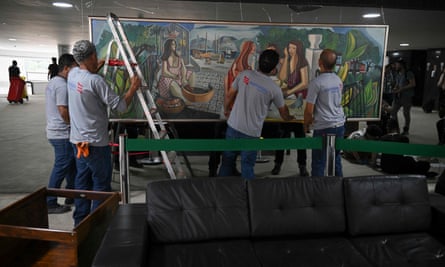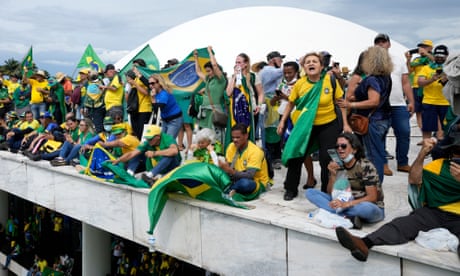BRAZIL: inside the wreckage of Brazil’s failed coup.
‘Bottles, glass, bullets’: inside the wreckage of Brazil’s failed coup. The Guardian

Rioters stormed Brazil’s congress, leaving a bizarre trail of destruction and fury in their wake
A blue Adolf Hitler moustache had been daubed on to a portrait of the Duke of Caxias, a 19th-century prime minister, on the second floor of Brazil’s presidential palace.

A multimillion-dollar masterpiece by the modernist legend Emiliano Di Cavalcanti was stabbed seven times.
Not even the palace’s press rooms escaped the wrath of thousands of far-right insurrectionists when they stormed the building on Sunday afternoon, as well as the national congress and supreme court.
After smashing their way into Oscar Niemeyer’s breathtaking curved creation, extremists relieved themselves in the press room and defecated in the room for photographers next door.
“The whole place stank of urine and beer,” one palace employee said of the moment officials re-entered the building after Sunday’s day of rage to discover scenes of inconceivable depredation.

The Guardian toured two of the three ransacked buildings in Brasília on Monday afternoon, 24 hours after the attack by hardcore followers of the former president Jair Bolsonaro.
The Planalto palace and the national congress are both architectural gems at the heart of Niemeyer and urban planner Lúcio Costa’s bold 1950s vision of a new, forward-looking Brazil.
Both now appear to have been hit by a natural disaster, their outer windows smashed to smithereens by rampaging Bolsonaristas desperate to overturn the result of October’s election, which their radical leader lost to his leftwing rival Luiz Inácio Lula da Silva.
At the senate museum, plaques still read: “Please do not touch the artwork.” But rioters ignored those as they swept into the exhibit room and began wrecking hundreds of years of Brazilian art and political history.
A knife had been taken to portraits of former senate presidents Renan Calheiros and José Sarney. A copy of the Brazilian constitution had been slammed through the top of a display case and was now framed by shards of broken glass.
Outside, the rightwing rebels had left artwork of their own; crudely scrawled graffiti demanding a pro-Bolsonaro military coup and an end to the communist threat they are convinced has taken hold of Brazil with Lula’s election win.
“Scumbags,” one cleaning lady fumed of the putschists as she and dozens of others swept congress’s glass-covered blue and lime green carpets and engineers checked for structural damage.

Nearby, the entrance to the offices of the senate’s current president, Rodrigo Pacheco, looked like a bank that had been targeted by ram-raiders. A Chinese X-ray machine lay on its side; chunks of glass covered the floor; internet cables dangled from the ceiling like vines; two shattered desktop computers lay on a table, their motherboards spilling out from inside.
At the presidential palace, there were similar scenes of gratuitous and often infantile destruction.
Cobblestones had been ripped up from the entrance, where just one week earlier hundreds of guests had celebrated Lula’s inauguration and what they had hoped would be a progressive new era of reconciliation and environmental protection after four years of division and hate.
Cleaners waded through the ornamental water features beneath the palace’s marble ramp using nets to fish out the detritus of the previous day’s chaos.
“Bottles, glass, [rubber] bullets,” one of the workers said of the objects being retrieved from the water mirror as the cleanup continued.
The rioters made it into the inner sanctum of what should be one of Brazil’s most secure addresses, leaving a bizarre trail of destruction and fury in their wake and many questions over how such a politically sensitive building could have been left so exposed.
The mob failed to access the offices of President Lula but other rooms were looted and smashed. A felt-tip pen was used to scrawl curly lines along the ceiling of the corridor occupied by members of the Institutional Security Bureau, which is responsible for the president’s safety. Chairs were hurled from the broken windows and rioters tried to torch a sofa.
One of Lula’s closest aides, Celso Amorim, said his office and that of Brazil’s first lady, Rosângela Lula da Silva, had been vandalized, with the insurgents appearing to trash her workplace with particular relish.
Amorim, who is Brazil’s former defence minister, said he was struggling to fathom how security forces and intelligence agencies had failed to detect or stop the threat. “The resistance only came after the deed had been done – it’s as if it was allowed to happen,” he said.
Journalists were not allowed into the third sacked building, the supreme court, on Monday afternoon as federal police forensic officers picked their way through its wreckage in search of fingerprints, clues and perhaps even booby traps left by the Bolsonaristas. But the white graffiti on the court’s facade spoke to the bedlam that had unfolded inside. “I came, I won,” said one daubed slogan. Another read: “You lost, you prick.”
As the Guardian approached the building, a black-clad member of the bomb disposal unit asked reporters to retreat: the controlled explosion of what he called “a grenade” was being carried out just metres from its entrance.
Minutes later, an ear-splitting bang rang out across the Three Powers Plaza, which Costa and Niemeyer had intended as a symbol of political harmony between Brazil’s executive, judiciary and legislative branches.
“It’s heartbreaking,” said a military policeman who was guarding the court and said several of his colleagues had been injured during the pro-Bolsonaro rampage. “Let us hope that better days lie ahead.”



Comentarios
Publicar un comentario